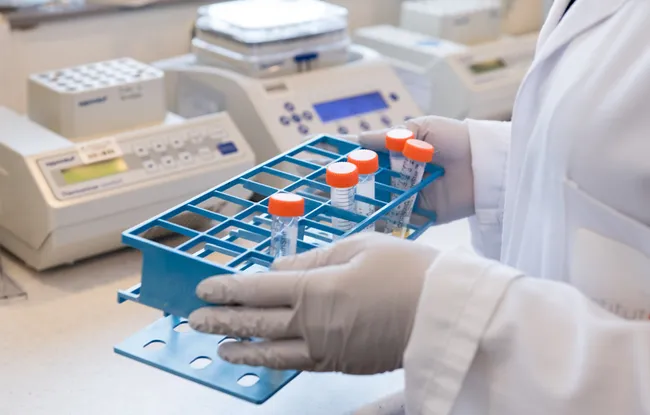- Home >
- Institut Curie News >
- A next-generation method for examining DNA replication using “single molecule” analysis
Researchers can now precisely and reliably visualize replication initiation sites. The results, published in Molecular Cell, open up the possibility of better understanding pathological phenomena such as cancer that can occur when the replication process malfunctions.
Mapping of early replication initiation events in human cells using a high throughput single molecule approach, namely Optical Replication Mapping (ORM). This method combines the Bionano Genomics approach to mapping long individual DNA molecules with in vivo fluorescent nucleotide pulse-labeling (red).
Replication is the biological process by which identical new DNA molecules are produced with every cell division on the chromosomal level. In human cells, replication begins at different initiation points in the genome, but the rules that govern the location, efficiency and activation period of replication initiation are unknown.
Institut Curie researchers, in international, multidisciplinary collaboration with teams in the United States and Canada, have taken an important step towards understanding the spatial and temporal parameters of the replication of the human genome, thanks to the development of a novel optical mapping method known as optical replication mapping, or ORM. By combining mapping long individual DNA molecules (the Bionano Genomics “single molecule” approach) with in vivo fluorescent nucleotide pulse-labeling, researchers can now analyze individual DNA molecules and identify sites of initiation and replication.
Our technology, which is unique in the world, gives us unprecedented precision: we can obtain data on 27 million ultra-long DNA fibers, each covering nearly 2,500 times the human genome.” Thanks to single-molecule analysis, are can now collect extremely precise and reliable information to identify genome-wide replication initiation sites
,enthuses Chunlong Chen, CNRS researcher and Institut Curie team lead.
Initial results reveal that replication initiation occurs heterogeneously in the genome. Furthermore, when they considered all the cells analyzed, the researchers were able to assert that any given initiation region is only active in 20% of cells (and inactive in 80%), showing low activation efficiency. Contrary to previously established beliefs, the origins of replication are not grouped: their distribution is random, confirming a fundamental feature of eukaryotic replication, conserved from yeast to humans. These replication program studies will provide a better understanding of the dynamics of replication and the role its deregulation plays in numerous pathologies, such as cancer and other genetic diseases.
Mapping of early replication initiation events in human cells using a high throughput single molecule approach, namely Optical Replication Mapping (ORM). This method combines the Bionano Genomics approach to mapping long individual DNA molecules (blue and greenlabels) with in vivo fluorescent nucleotide pulse-labeling (red).
Citation: Genome-wide mapping of human DNA replication by optical replication mapping supports a stochastic model of eukaryotic replication. Weitao Wang; Kyle N.Klein; Karel Proesmans; Hongbo Yang; Claire Marchal; Xiaopeng Zhu; Tyler Borrman; Alex Hastie; Zhiping Weng; John Bechhoefer#, Chun-Long Chen#; David M. Gilbert#; Nicholas Rhind#. Molecular Cell, June 2021. https://doi.org/10.1016/j.molcel.2021.05.024
Research News
Discover all our news
Celebration
The Immunity and Cancer research unit (U932) celebrates its twentieth anniversary
12/12/2025
Artificial Intelligence
08/12/2025




